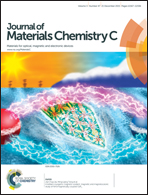Modifying a charge density wave transition by modulation doping: ferecrystalline compounds ([Sn1−xBixSe]1.15)1(VSe2)1 with 0 ≤ x ≤ 0.66†
Abstract
A series of alloyed ferecrystals ([Sn1−xBixSe]1.15)1(VSe2)1 with 0 ≤ x ≤ 0.66 was synthesized via the modulated elemental reactants technique. X-ray diffraction of the compounds reveals systematic changes of the lattice parameter and the intensities of the Bragg peaks confirming the successful alloying of the compounds corroborated by Rietveld refinements. Interestingly, both constituents of the intergrowth compounds exhibit systematic structural changes as a function of the Bi-content indicating interlayer interaction. The a-axis lattice parameter of the VSe2 layer expands with increasing Bi-content, which signifies changes in the electronic structure of this constituent. Electrical resistivities, Hall and Seebeck coefficients of compounds with a varying Bi-content present a complex scenario. At low Bi-contents an enhancement of the charge density wave transition is observed, whereas further substitution results in a suppression of the effect. At Bi-contents exceeding x = 0.55 minority carriers from the Sn1−xBixSe layer contribute to the transport properties.
![Graphical abstract: Modifying a charge density wave transition by modulation doping: ferecrystalline compounds ([Sn1−xBixSe]1.15)1(VSe2)1 with 0 ≤ x ≤ 0.66](/en/Image/Get?imageInfo.ImageType=GA&imageInfo.ImageIdentifier.ManuscriptID=C5TC03130C&imageInfo.ImageIdentifier.Year=2015)

 Please wait while we load your content...
Please wait while we load your content...